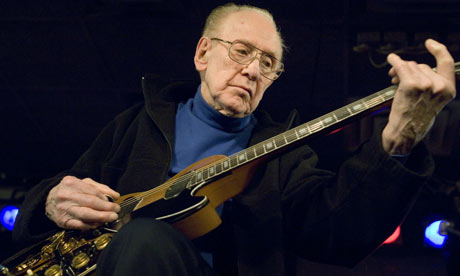Guitarist and inventor with huge influence on pop and jazz

Guitar legend Les Paul performing at 91 at the Iridium Jazz Club in New York in 2007. Photograph: Colin Archer/AP
In that setting, the records of Les Paul, who has died aged 94, and his partner Mary Ford were simultaneously throwbacks to an earlier Tin Pan Alley and wittily modern. On paper, they were a competent nightclub singer and a technically superb session guitarist, reviving such faded blooms of the music publishers' back catalogue as Nola, Tiger Rag and The World Is Waiting for the Sunrise. On disc, they were legion: Ford, multitracked, became a vocal group, while Paul, not only multitracked but at several different speeds, turned into an orchestra of guitars, some twanging in the recognisable accents of country or, others skittering octaves above like harmonised bats, all to a beat of rigorous simplicity.
Born in Waukesha, Wisconsin, Paul was always fascinated by sounds and their preservation. At the age of nine, he is said to have set himself the puzzle: "Why does my window rattle when the train goes by?" Soon afterwards he built a home recording machine out of gramophone and car parts. As a teenage guitar and banjo prodigy, he was billed as Red Hot Red, the Wizard of Waukesha, and joined a western band on Chicago's powerful radio station WLS.
By the mid-1930s he had the reputation of a versatile studio musician, working without strain not only in hillbilly settings but alongside jazz artists including Louis Armstrong. Among his early recordings were accompaniments to the blues singer and pianist Georgia White. He tentatively opened his own recording career in 1936 with four country songs for the Montgomery Ward mail-order store's budget label, under the sobriquet Rhubarb Red.
Later in the decade his jazz-flavoured trio – partly modelled on the ensembles of Django Reinhardt, whom he greatly admired – became nationally known on bandleader Fred Waring's radio show. He also participated in one of the earliest NBC telecasts. For most of the 40s, he was based in Hollywood, accompanying artists such as Bing Crosby and the Andrews Sisters on radio and records. In 1944, he joined the roster of Jazz at the Philharmonic for a concert.
During this period, he developed "the log", a solid-body electric guitar made from a piece of maple. He also conceived, with the help of the new reel-to-reel tape recorder, the trick effects of "sound-on-sound" (overdubbing), slapback echo and speed-changing, which he would deploy in his duets with Ford, who joined him in 1947, recommended by Gene Autry. They married in 1949 and the following year moved to New York to begin a television series, Les Paul and Mary Ford at Home, on which they launched their records.
Among their many hits were Mockingbird Hill and the chart-topping How High the Moon and Vaya Con Dios. In their book What Was The First Rock'n'Roll Record?, Jim Dawson and Steve Propes ascribe to How High the Moon "the first distinct 'rock'n'roll' guitar solo... Nearly every solo by Danny Cedrone of Bill Haley and His Comets refers to it. Cedrone's striking work on Rock Around the Clock is almost an echo of the Les Paul style."
"I've never let anybody know exactly what kind of pick-ups or how I get my sound on records or onstage," Paul once said. "That big, fat, round, ballsy sound with the bright high end is the Les Paul sound – nobody else has it."
The Paul-Ford formula waned after the arrival of full-blown rock'n'roll, and they divorced in 1964; Ford died in 1977. Paul continued to innovate in guitar and recording technology, and is credited with inventing the eight-track tape recorder. The Les Paul guitar, manufactured by the Gibson guitar company, came to be highly regarded by rock guitarists.
In the mid-70s Paul re-emerged as a performer to play concerts with the country guitar virtuoso Chet Atkins, whose older brother Jimmy had played rhythm guitar in Paul's trio 40 years before. Their 1977 album Chester and Lester won a Grammy.
In 1980, Paul underwent heart surgery but recovered to resume playing, and had regular engagements at two New York jazz clubs, Fat Tuesday's and the Iridium. He won a second Grammy in 2006 for the LP Les Paul & Friends: American Made World Played.
No conservative about guitar players – he was an early admirer of Jimi Hendrix – he would occasionally appear on stage with rock stars such as Jeff Beck. In 2008, when he received an American Music Masters award from the Rock and Roll Hall of Fame, the concert was attended by admirers including Duane Eddy, James Burton and Slash. His remarkable career has been surveyed in two documentaries, The Wizard of Waukesha (1980) and Chasing Sound: Les Paul at 90 (2007).
By his first wife, Virginia Webb, he had two sons, and the couple divorced. By Mary, he had a son and a daughter. His four children survive him, as does his companion, Arlene Palmer.
Les Paul (Lester William Polsfuss), guitarist and inventor, born 9 June 1915; died 13th August 2009
guardian.co.uk © Guardian News and Media Limited 2009


No comments:
Post a Comment